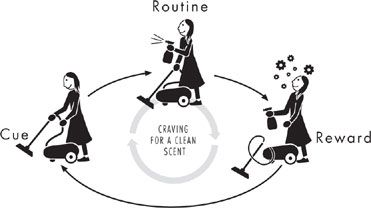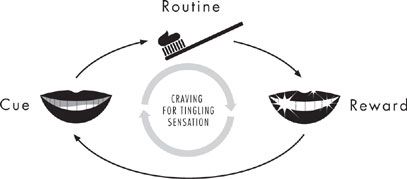Read The Power of Habit: Why We Do What We Do in Life and Business Online
Authors: Charles Duhigg
Tags: #Psychology, #Organizational Behavior, #General, #Self-Help, #Social Psychology, #Personal Growth, #Business & Economics
The Power of Habit: Why We Do What We Do in Life and Business (11 page)

Each change was designed to appeal to a specific, daily cue: Cleaning a room. Making a bed. Vacuuming a rug. In each one, Febreze was positioned as the reward: the nice smell that occurs at the end of a cleaning routine. Most important, each ad was calibrated to elicit a craving: that things will smell as nice as they look when the cleaning ritual is done. The irony is that a product manufactured to destroy odors was transformed into the opposite. Instead of eliminating scents on dirty fabrics, it became an air freshener used as the finishing touch, once things are already clean.
When the researchers went back into consumers’ homes after the new ads aired and the redesigned bottles were given away, they found that some housewives in the test market had started expecting—craving—the Febreze scent. One woman said that when her bottle ran dry, she squirted diluted perfume on her laundry. “If
I don’t smell something nice at the end, it doesn’t really seem clean now,” she told them.
“The park ranger with the skunk problem sent us in the wrong direction,” Stimson told me. “She made us think that Febreze would succeed by providing a solution to a problem. But who wants to admit their house stinks?
“We were looking at it all wrong. No one craves scentlessness. On the other hand, lots of people crave a nice smell after they’ve spent thirty minutes cleaning.”

THE FEBREZE HABIT LOOP
The Febreze relaunch took place in the summer of 1998. Within two months, sales doubled.
Within a year, customers had spent more than $230 million on the product.
2.30
Since then, Febreze has spawned dozens of spin-offs—air fresheners, candles, laundry detergents, and kitchen sprays—that, all told, now account for sales of more than $1 billion per year. Eventually, P&G began mentioning to customers that, in addition to smelling good, Febreze can also kill bad odors.
Stimson was promoted and his team received their bonuses. The formula had worked. They had found simple and obvious cues. They had clearly defined the reward.
But only once they created a sense of craving—the desire to make everything smell as nice as it looked—did Febreze become a hit. That craving is an essential part of the formula for creating new habits that Claude Hopkins, the Pepsodent ad man, never recognized.
In his final years of life, Hopkins took to the lecture circuit. His talks on the “Laws of Scientific Advertising” attracted thousands of people. From stages, he often compared himself to Thomas Edison and George Washington and spun out wild forecasts about the future (flying automobiles featured prominently). But he never mentioned cravings or the neurological roots of the habit loop. After all, it would be another seventy years before the MIT scientists and Wolfram Schultz conducted their experiments.
So how did Hopkins manage to build such a powerful toothbrushing habit without the benefit of those insights?
Well, it turns out that he actually
did
take advantage of the principles eventually discovered at MIT and inside Schultz’s laboratory, even if nobody knew it at the time.
Hopkins’s experiences with Pepsodent weren’t quite as straightforward as he portrays them in his memoirs. Though he boasted that he discovered an amazing cue in tooth film, and bragged that he was the first to offer consumers the clear reward of beautiful teeth, it turns out that Hopkins wasn’t the originator of those tactics. Not by a long shot. Consider, for instance, some of the advertisements for other toothpastes that filled magazines and newspapers even before Hopkins knew that Pepsodent existed.
“The ingredients of this preparation are especially intended to prevent deposits of
tartar
from accumulating around the necks of the teeth,” read an ad for Dr. Sheffield’s Crème Dentifrice that predated Pepsodent. “Clean that dirty layer!”
“Your white enamel is only
hidden
by a coating of film,” read an advertisement that appeared while Hopkins was looking through his dental textbooks. “Sanitol Tooth Paste quickly restores the original whiteness by removing film.”
“The charm of a lovely smile depends upon the beauty of your teeth,” proclaimed a third ad. “Beautiful, satin smooth teeth are
often the secret of a pretty girl’s attractiveness. Use S.S. White Toothpaste!”
Dozens of other advertising men had used the same language as Pepsodent years before Hopkins jumped in the game. All of their ads had promised to remove tooth film and had offered the reward of beautiful, white teeth. None of them had worked.
But once Hopkins launched his campaign, sales of Pepsodent exploded. Why was Pepsodent different?
Because Hopkins’s success was driven by the same factors that caused Julio the monkey to touch the lever and housewives to spray Febreze on freshly made beds. Pepsodent created a craving.
Hopkins doesn’t spend any of his autobiography discussing the ingredients in Pepsodent, but the recipe listed on the toothpaste’s patent application and company records reveals something interesting:
Unlike other pastes of the period, Pepsodent contained citric acid, as well as doses of mint oil and other chemicals.
2.31
Pepsodent’s inventor used those ingredients to make the toothpaste taste fresh, but they had another, unanticipated effect as well. They’re irritants that create a cool, tingling sensation on the tongue and gums.
After Pepsodent started dominating the marketplace, researchers at competing companies scrambled to figure out why. What they found was that customers said that if they forgot to use Pepsodent, they realized their mistake because they missed that cool, tingling sensation in their mouths. They expected—they
craved—
that slight irritation. If it wasn’t there, their mouths didn’t feel clean.
Claude Hopkins wasn’t selling beautiful teeth. He was selling a sensation. Once people craved that cool tingling—once they equated it with cleanliness—brushing became a habit.
When other companies discovered what Hopkins was really selling, they started imitating him. Within a few decades, almost every toothpaste contained oils and chemicals that caused gums to tingle. Soon, Pepsodent started getting outsold. Even today, almost all
toothpastes contain additives with the sole job of making your mouth tingle after you brush.

THE REAL PEPSODENT HABIT LOOP
“Consumers need some kind of signal that a product is working,” Tracy Sinclair, who was a brand manager for Oral-B and Crest Kids Toothpaste, told me. “We can make toothpaste taste like anything—blueberries, green tea—and as long as it has a cool tingle, people feel like their mouth is clean. The tingling doesn’t make the toothpaste work any better. It just convinces people it’s doing the job.”
Anyone can use this basic formula to create habits of her or his own. Want to exercise more? Choose a cue, such as going to the gym as soon as you wake up, and a reward, such as a smoothie after each workout. Then think about that smoothie, or about the endorphin rush you’ll feel. Allow yourself to anticipate the reward. Eventually, that craving will make it easier to push through the gym doors every day.
Want to craft a new eating habit? When researchers affiliated with the National Weight Control Registry—a project involving more than six thousand people who have lost more than thirty pounds—looked at the habits of successful dieters, they found that 78 percent of them ate breakfast every morning, a meal cued by a time of day.
2.32
But most of the successful dieters
also
envisioned a specific reward for sticking with their diet—a bikini they wanted to wear or the sense of pride they felt when they stepped on the scale each day—something they chose carefully and really wanted. They focused on the craving for that reward when temptations arose, cultivated
the craving into a mild obsession. And their cravings for that reward, researchers found, crowded out the temptation to drop the diet.
The craving drove the habit loop.
2.33
For companies, understanding the science of cravings is revolutionary. There are dozens of daily rituals we
ought
to perform each day that never become habits. We should watch our salt and drink more water. We should eat more vegetables and fewer fats. We should take vitamins and apply sunscreen. The facts could not be more clear on this last front: Dabbing a bit of sunscreen on your face each morning significantly lowers the odds of skin cancer.
Yet, while everyone brushes their teeth, fewer than 10 percent of Americans apply sunscreen each day.
2.34
Why?
Because there’s no craving that has made sunscreen into a daily habit. Some companies are trying to fix that by giving sunscreens a tingling sensation or something that lets people know they’ve applied it to their skin. They’re hoping it will cue an expectation the same way the craving for a tingling mouth reminds us to brush our teeth. They’ve already used similar tactics in hundreds of other products.
“Foaming is a huge reward,” said Sinclair, the brand manager. “Shampoo doesn’t have to foam, but we add foaming chemicals because people expect it each time they wash their hair. Same thing with laundry detergent. And toothpaste—now every company adds sodium laureth sulfate to make toothpaste foam more. There’s no cleaning benefit, but people feel better when there’s a bunch of suds around their mouth. Once the customer starts expecting that foam, the habit starts growing.”
Cravings are what drive habits. And figuring out how to spark a craving makes creating a new habit easier. It’s as true now as it was almost a century ago. Every night, millions of people scrub their teeth in order to get a tingling feeling; every morning, millions put on their jogging shoes to capture an endorphin rush they’ve learned to crave.
And when they get home, after they clean the kitchen or tidy their bedrooms, some of them will spray a bit of Febreze.
 THE GOLDEN RULE OF HABIT CHANGE
THE GOLDEN RULE OF HABIT CHANGEWhy Transformation Occurs
I.
The game clock at the far end of the field says there are eight minutes and nineteen seconds left when Tony Dungy, the new head coach of the Tampa Bay Buccaneers—one of the worst teams in the National Football League, not to mention the history of professional football—starts to feel a tiny glimmer of hope.
3.1
It’s late on a Sunday afternoon, November 17, 1996.
3.2
The Buccaneers are playing in San Diego against the Chargers, a team that appeared in the Super Bowl the previous year. The Bucs are losing, 17 to 16. They’ve been losing all game. They’ve been losing all season. They’ve been losing all decade. The Buccaneers have not won a game on the West Coast in sixteen years, and many of the team’s current players were in grade school the last time the Bucs had a victorious season. So far this year, their record is 2–8. In one of those games, the Detroit Lions—a team so bad it would later be
described as putting the “less” in “hopeless”—beat the Bucs 21 to 6, and then, three weeks later, beat them again, 27 to 0.
3.3
One newspaper columnist
has started referring to the Bucs as
“America’s Orange Doormat.”
3.4
ESPN is predicting that Dungy, who got his job only in January, could be fired before the year is done.
